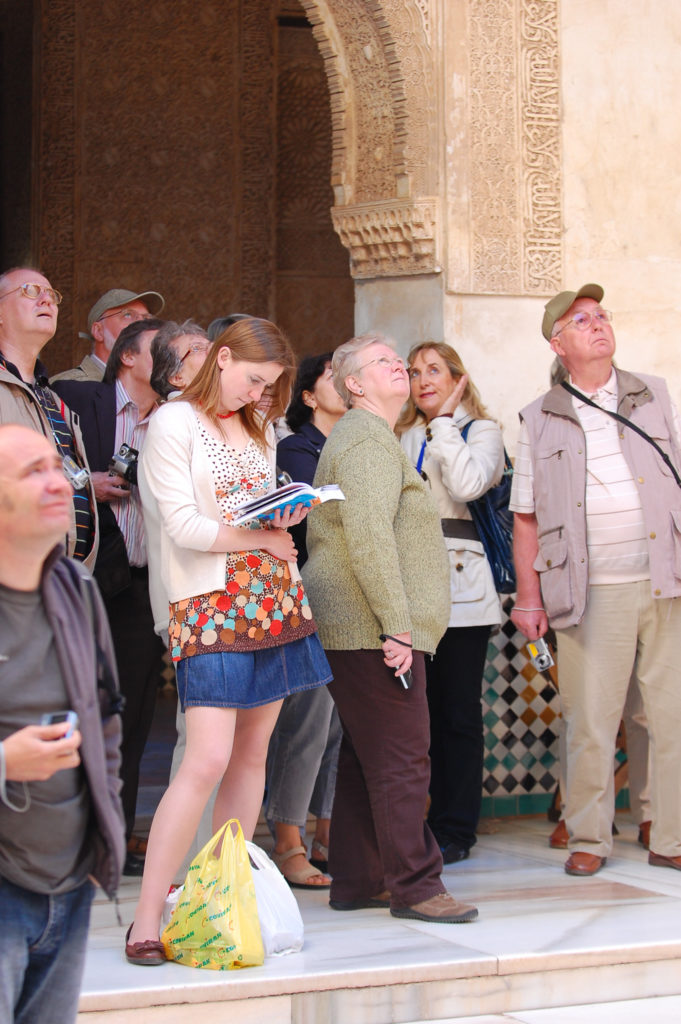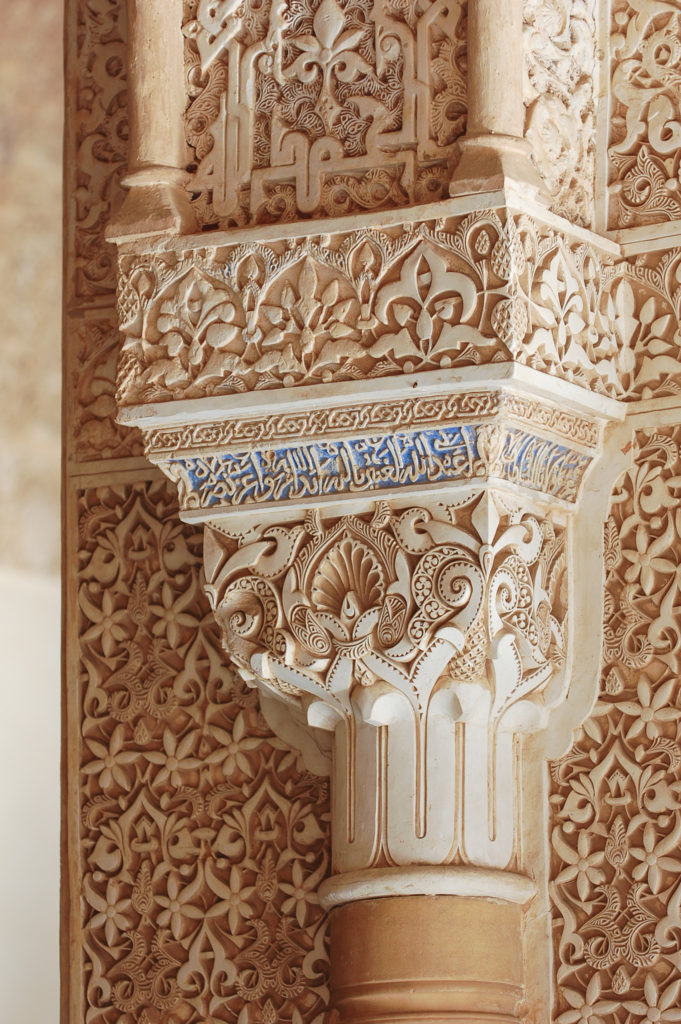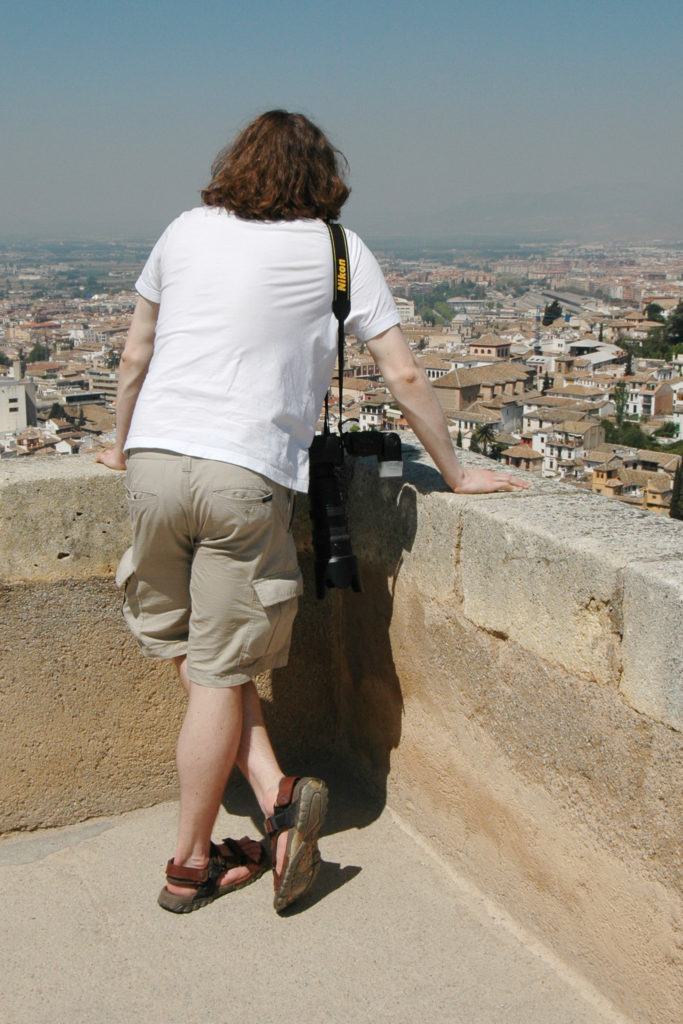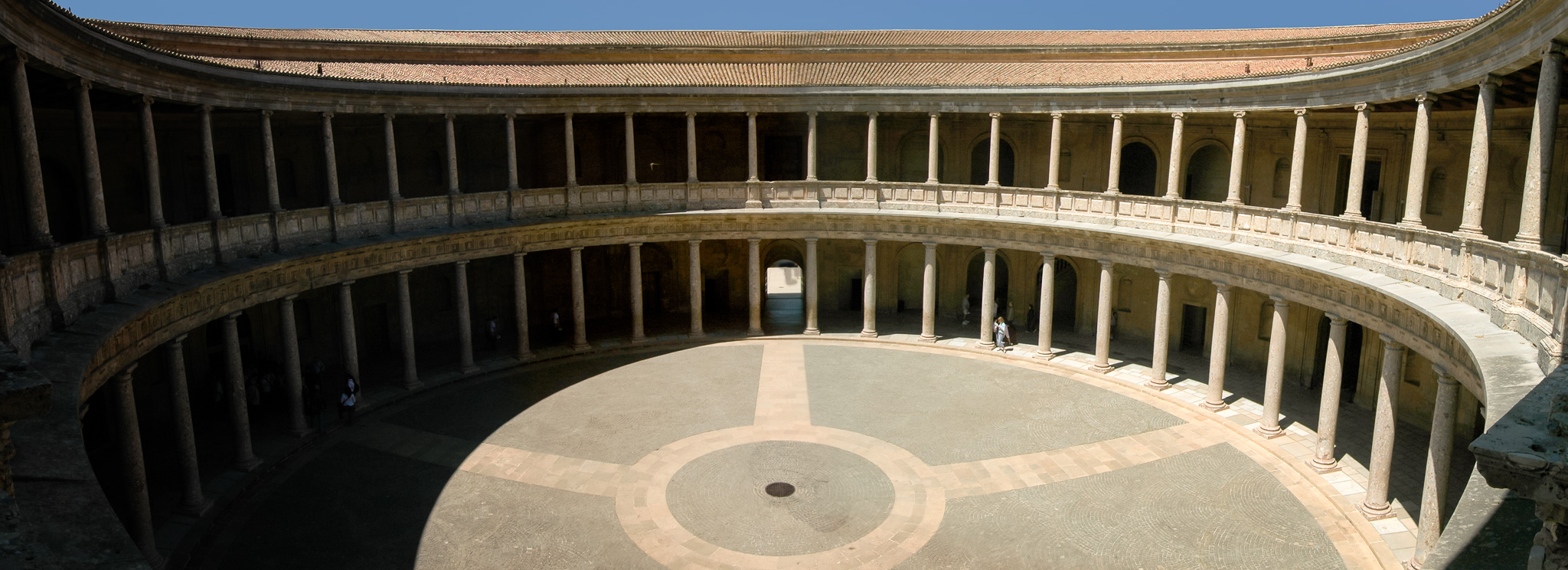
Granada’s Alhambra palace towers over the city—a skyline-dominating, glorious edifice draped before the snow-capped natural wonder of the highest peaks of the Sierra Nevada. Guidebook writers are left agog, dribbling as they fawn, to the point where only smearing the ink in every guidebook with genuine saliva could further emphasise the towering palace of superlatives describing it.
Europe’s most superlative monument, though, is also Europe’s most stressful. Today, my girlfriend Rosalind and I visited the Alhambra. Here is documented the tale of what did come to pass.
We awoke at 07:30. In a bid to preserve the Alhambra, and indeed make visiting it bearable, only 8,100 tourists are allowed to pass her sensual lips on a daily basis. We had been advised by a friend, who visited last August, that booking ahead was the only option—she’d arrived at the crack of dawn to find a six-hour queue with no promise of tickets at the end of it. Not wanting our holiday ruined by the popular monument’s monumental popularity, we booked plenty ahead.
We had also read that the most spectacular part of the Alhambra is the Nasrid palace, a play-den of sultans and the most sublime example of Moorish architecture still standing (which, given that it started standing in the fourteenth century, is worthy of accolade). What the guidebooks don’t make apparent is that this is a fairly small part of the Alhambra, do-able in a couple of hours, even if you spend a lot of time poring over the patterns. Don’t get me wrong, there are plenty of patterns—but there’s only so much space in the human mind to absorb them. What the guidebook did tell us was that you’re allocated a half-hour slot to get in, to keep the flow of people sane but, once you’re in, you’re in, and you can pore, saunter and loiter until the geometry has driven you so mental that whenever you close your eyes, you see square spirals on the inside of your eyelids and forget which way is ‘up’. We chose the 09:00 time slot for entry to the palaces, giving us, we thought, a full day of Alhambra goodness. A full morning of Granada stress, more like.
We’d left the hostel by 08:00. In case you’re not privy to the cliché: Spain does not wake up at 08:00. In central London at this time on a Wednesday morning, you’d be crushed in crowds of servile pricks, jostling their way to jobs they detest, corner shops and Starbucks littering any route you might happen to choose with dispiriting regularity. Not so in Granada. Half an hour weaving between main streets and backstreets, and we were getting jittery: nowhere was open. All we wanted was a couple of loaves of bread, and maybe five fishes, you know, to keep us going.
We eventually happened upon a posh deli/baker-type place and, desperate for any sustenance they might ply us with, entered. We came away with a croissant, a pain au chocolat and what turned out to be an enormous loaf of weirdly Spanish spiced bread which tasted something like posh herbal soap smells. We broke into a half-jog and began ascending the enormous hill up to the Alhambra.
As luck would have it, we stumbled across a very mini supermarket as we climbed, and managed to hurriedly grab a few more provisions; some cheese (which wouldn’t go very well with what we had yet to discover was weirdly spiced bread), some fruit, some chocolate, that kind of thing. We jogged some more.

The gate
After getting lost several times (for Granada’s preeminent tourist attraction, signage leaves something to be desired), we finally happened upon the mad ticket office. It was there that we avoided the only pitfall of the day we managed to avoid by not being questioned about our status as students, thus garnering us the same tickets, but saving us a cool couple of quid, or something. The next bit, having got past the ticket machine, was to get past security.
The security guards at the Alhambra are scary. Really scary. They are armed with an enormous baton, handcuffs and some of them carry a gun. Just re-read that to save me writing it again. I will write it again anyway. A gun. A fucking gun, and a few bullets around their belts next to the gun, to ram the point home. The Alhambra is definitely picturesque, but does it need that level of protection? What could possibly justify the use of lethal force against a tourist? I don’t care if they’re naked but for a sombrero, shitting in the fountain on el Patio de los Leones, whilst splashing the eponymous marble lions with hydrofluoric acid, you should probably still ask questions first, and shoot later.
Even more terrifying, the guards are neither from the Spanish army nor police—they’re from a private security firm. The final straw of terror for the weak-stomached liberals amongst you? It appears that the Spanish word for security guard is ‘vigilante’.
The one on the gate wasn’t having any of it. By ‘it’ I mean rucksacks larger than a shoebox, and by ‘not having any of’ I mean ‘sent us to some weird left luggage in a basement’. The left luggage was manned by a polite young girl who kindly sat behind her glass screen and radioed for a security guard to come and X-ray our bags. It appears that the attendant was not allowed to carry out the one task which was necessary as part of her job, viz, putting bags into lockers. The security guard was very slow coming, but this was slightly lucky as we were fairly slow ramming all of my camera gear into every pocket of my combat shorts. It was quite a painful experience as I had taken quite a lot of camera gear in anticipation of the Alhambra being quite pretty. My girlfriend spent the time putting all our other possessions into the extremely thin yellow carrier bag we had got from the tiny supermarket.
The security guard eventually turned up and scanned our (empty, because we’d taken all the stuff out of them) rucksacks and confirmed that indeed they were not full of guns and bombs (though no such check was performed on us or anyone else who was actually going in to the palace, rather than staying locked safely in a basement a short distance away), allowing us to go back up to the first arsey security guard, who was busy letting a load of people with large rucksacks into the palace. She looked me up and down, dripping with camera equipment, and thought ‘Twat,’ before scanning my ticket. ‘You reduced me to this,’ I replied, in withering stare. Her evil side melted away, however, when she noticed that our entry slot to the Nasrid palace, printed on our tickets, ended in about six minutes. In slightly broken English she explained that it was on the other side of the Alhambra; reading between the lines, I suspected probably about a five and a half minutes’ run.
And so it was we sprinted through one of Europe’s most tranquil gardens, my girlfriend lugging stuffed carrier bags like some kind of hobo, me festooned, a camera on each shoulder, pockets rammed with lenses, and a polarising filter digging very, very painfully into my right leg. My lungs were on fire and my stomach a gurgling vacuum as we were rushed to the front of the queue of punters waiting to enter the palace. And I really needed a wee.
The Nasrid Palace
The Nasrid palace is truly breathtaking. It consists of a succession of rooms and courtyards, each beautiful, serene and implausibly, painstakingly intricate. Every exposed surface on the walls and ceilings is crammed with carvings. From a distance it looks like the wall has a big pattern and some texture, but closer inspection shows that this is not merely roughness, but an explosion of detail; a succession of ever-smaller Arabic writing, leaves and geometric patterns; the fractal dream of an insane mason armed with only a toothpick, too much spare time and a trance-like oneness with reality. Every step closer reveals deeper complexity and meaning; an elegant self-similarity; a great big ‘fuck you’ to polygon counts.

It would be totally impossible to set a first-person shooter in the Alhambra. Not because it would be sacrilege, not because the terapixel textures might set your computer on fire, but because, if you did manage to faithfully recreate the palace, the overawing serenity would render even the most vicious, RPG-wielding AI sprite a peaced-out stoner, ambling, breathing, just perceiving, drinking in the moreish Moorish craftsmanship.
Its calming influence succeeded in draining some of the knackered, starving, grumpy burden from me. Though sadly it did not manage to do the same with the wee.
We managed to kill a good hour and a half, maybe two hours, wandering around, staring, and trying to surreptitiously eat food. There are plenty of signs about the place warning you in pictures that food is in some way disallowed, but it is not clear from the sandwich with a line through it whether it’s use, possession or dealing which will get you a cap is the ass from security. It’s definitely at least eating which isn’t allowed, though, and security are pretty eagle-eyed, even if you try to snaffle a handful of croissant ripped off whilst pretending to take a photograph of a particularly interesting column. I say that non-sarcastically: there are plenty of particularly interesting columns. Doric, ionic and Corinthian can fuck off: implausibly intricate and Moorish is my new favourite type of column. But love of columns, I found, cannot fill the bellies of the starving.

By the time we had made it out, my priorities had been slightly rearranged: I’d snaffled at least a few mouthfuls of croissant, but had not weed in the two hours since I had started really needing a wee, so I decided it was time to dash to the toilet. It was at this point, whilst I was in the loo, that my girlfriend had our next encounter with security.
She decided to eat her pain au chocolat on some seating outside the building with the loos in it, but an arsey female security guard with bright red hair caught sight of this atrocity, and started spouting shouted Spanish. My girlfriend deployed the only phrase she knew which would be of any use at this point—‘¡No hablo español!’ (For those of you who really don’t speak Spanish, that means ‘I don’t speak Spanish!’) This did not stop the security guard’s spiel. Rosalind kept repeating ‘¡No hablo español, no hablo español!’ but the vigilante pulled her gun and cocked it, still shouting, gesturing repeatedly, pointing the firearm first at the offending bakery product, and then the floor. Rosalind raised her hands, quivering slightly. The security guard kept shouting, gesturing ever-more insistently. The gesticulation eventually broke through the language and terror barrier, and Rosalind dropped the pain au chocolat on the floor and stood up slowly, before kicking her former breakfast across the dusty ground to the angry woman. The gun followed the pain across the floor and, once it had skidded to a halt, the guard let off three rounds into it in quick succession, holstered her weapon and grabbed her walkie-talkie. ‘Food threat in sector B5 neutralised,’ she said, tersely, ‘deploy a clean-up team,’ before walking off briskly.
Rosalind was still frozen, hands up, shaking visibly; slowly, she noticed a circle of people gathering around her. They were staring, awed, at the shards of pastry and the small pool of chocolate, melting in the rising heat of the morning Sun. The silence hung for what seemed like minutes, until an American woman looked up and broke it: ‘The guard says you can only eat in the designated eating area, just over there,’ she offered, quietly, ‘I’m sorry for your loss.’
The Alcazaba
I returned from the best wee ever to find Rosalind slightly shaken (but in better shape than her breakfast) and we decided that we should perhaps finish our weird picnic in the designated eating area which was, by good fortune, quite near to where we were, and also near to the next item on our Alhambra agenda, the Alcazaba.

Perfectly located and stunning edifice though the Alhambra may be, let no-one tell you it has any architectural coherence. It is a whopping, disjointed self-anachronism, and walking straight from the Nasrid palace in its toothpick-carved intricacy to the Alcazaba, an unsubtle military structure from centuries previous, rams the inconsistency home with a touch as light as US foreign policy. It is a fortress with high, flat, featureless, foothold-free walls. Walking around it feels like going around a strangely subtropical English Heritage castle. It even has a series of small walls where archaeological excavations have uncovered former rooms in what I suppose over here we’d call the inner keep.
However, though the design may be stark, the location saves it—it sits in a commanding position over Granada, at the tip of the Alhambra’s tapering hilltop. Atop the mighty tower at its prow, surveying the whole city, the plains beyond and the mountains looming behind, I happened upon a couple of Americans.
‘Gee,’ said one to the other. ‘In some parts of Granada you would never guess you weren’t in Morocco.’ (It was testament to his well-travelled erudition that he had noticed the few subtle parallels between north African and southern Spanish architecture and design.)
His friend, by way of responding, made a weird noise which I can only assume was a (slightly racist) imitation of snake-charming music.
The first one looked back and, nodding rhythmically like a surfer dude twat, said ‘Awesome.’
I have never, ever in my life overheard such a naïve, culturally ignorant, essentially American exchange since the last time I was stood atop a tall thing next to some Americans. I thought nothing could beat the last one, but from the nation which brought us the War on Terror, Friends and turducken, anything is possible. It’s the American dream.
The Palace of Carlos V
The next stop in any good tour of the Alhambra is the Palace of Carlos V. Carlos V was a widely-reviled monarch of Spain who not only didn’t speak Spanish, but also seemed to enjoy ripping down priceless monuments. He was taken with the Alhambra, and decided that he’d quite like to live there, so commissioned a brash, Roman-style palace to be placed on top of some Moorish stuff, which wild guessing with no evidence suggests to me was probably slightly prettier.
As we entered the palace, an enthusiastic American tour guide was explaining its shape: ‘Now, here we are in the palace, can anyone remember what shape the palace was outside?’ He paused for a moment for suggestions. ‘Yes! That’s right, it was square! However, as you can see, the inside of the palace is circular.’ He gestured in a broad sweep around the interior patio, styled with delusions of grandeur after the Colosseum. ‘So, even though it’s square on the outside, it’s round on the inside. Circular on the inside, square on the outside.’ He continued to emphasise this fairly simple point of geometry, animatedly enthusing like a topologist who has just discovered a new class of six-dimensional tie knots based on a Dime bar (‘soft on the outside, SU(3) symmetric on the inside, armadillos!’).

The palace, like so many projects born of pride, ended up unfinished due to a cash shortage. Carlos could not afford its third level, nor even to put a roof over the top of the second one. Luckily, some money was scraped together by kindly souls in the 1960s who evidently wanted Carlos to appear slightly less of a tit, or possibly for his stupid, anachronistic palace to look like slightly less of a grandiose, incomplete pimple in its majestic surroundings. Don’t get me wrong; in any other location it would be pompous and austere but still spectacular. It’s just that building it in the middle of the Alhambra is a little misjudged, like turning up to the Olympics in plimsolls.

The gardens and Generalife
Next stop, if you can call the sprawling gardens a ‘stop’ given their large spatial extent, was the gardens. These form the bulk of the Alhambra in area and, if you’re not sprinting through them with camera accessories jabbing your thighs, serene they are indeed. Row upon row of manicured hedging, sculpted trees and immaculate borders…makes it sound slightly like a country house, but something about the slightly exotic plants, the quality of the light and the by-now searing afternoon heat made it ooze ‘legend’. It is not much of a stretch to imagine sultans and princesses idly drifting through these gardens, nibbling on sweetmeats brought from all corners of the known world, attended by crowds of servants and swordsman. Unfortunately, my lamentable historical knowledge of both the era and location meant that I was actually imagining Princess Jasmine from Disney’s Aladdin skipping through the gardens, occasionally stopping to stroke the implausibly enormous feet of her anthropomorphised tiger. Unlike an American, however, I kept this thought to myself, rather than breaking into a rendition of A Whole New World whilst dancing like an Egyptian à la The Bangles.
The final part of the Alhambra is the Generalife. Though it sounds like a health insurer, in Spanish its pronunciation actually makes one sounds like they have a phlegmy chest infection and may shortly need the services of one. It is another palace on a slightly different site, sat in its own spectacular gardens. Sadly, I have no exciting stories nor any particular recommendations from here because we never got in. The final and least clear restriction on your Alhambra ticket is that you either get a morning or afternoon slot (and the Spanish, working as they do slightly behind regular time, draw the crossover line at midday—so 14:00) and, by the time we’d meandered to the gates of the Generalife, we’d meandered clean past the deadline—by about two hours. It was here that we had our final, slightly lower-key run-in with security: the bloke on the gate wouldn’t let us in. He was middle-aged and rather nice about it really; one got the impression that it was more than his job was worth to let a couple of sweaty English tourists past him without scanning the funny codes on their tickets through his machine, and so after a little attempted negotiation and eyelash-fluttering from both myself and my girlfriend (in the spirit of hedging our bets—you never know), we were turned away.
Epilogue
So that was it. We got our bags back from the funny underground locker room and stuffed all the stuff back in them, and were left to wander the streets of Granada for the late afternoon and evening.
La Alhambra is the only tourist attraction I have ever had a stress dream about. However, now you’re prepared by this mammoth ’blog entry, I can only recommend it. Take it easy, book a late slot for the Nasrid palace and make sure you’ve got a handgun on you (but not in your large rucksack), and the incomprehensible tranquillity of the place is without compare. Until you try to nibble a croissant and a firefight breaks out with security.
If only I had read this before I went there last month! Had a late afternoon slot for the Nasrid Palaces, but managed to be late after some confusion with buses, and carrying a can of coke – which went down badly as you can imagine… Couldn’t be bothered with the Generalife as it was so bloody hot I just wanted to be out of there with a cold beer. Wonder if everyone who visits has a similarly stressful experience?
Well that solves that one! I was trying to find out if we can take a picnic. A wonderful account. Thank you
Wonderful and amusing account. I was looking for the specific pronunciation of Generalife, alas. But I wondering at what time of year is the best to visit, considering I love gardens and am “older”. Standing in line for hours, hot sun, etc., would do me in, alas!